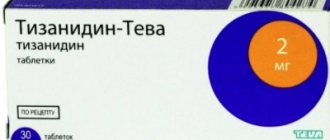- October 29, 2018
- Other drugs
- Gladkikh Asya
In this article we will look at what Sirdalud tablets are for.
The drug may affect the tone of skeletal muscles, exhibiting a moderate analgesic effect. This drug belongs to the group of muscle relaxants. Its active component is the substance tizanidine, which is quite well known in pharmacology.
About the drug
Not everyone knows why Sirdalud tablets help. This drug acts on skeletal muscles, and its use produces a moderate analgesic effect. The scope of application of this remedy is considered to be the presence in the body of a spastic disorder of cerebral and spinal origin. Failure can be expressed in chronic or acute form.
The drug "Sirdalud" reduces the manifestation of spasms and clonic convulsions. The active substance is absorbed fairly quickly and almost completely when taken orally. Its maximum concentration in plasma is observed, as a rule, within an hour after taking the drug. The medication is excreted in the urine. Eating at the same time as taking pills does not affect the pharmacokinetic process or absorption. Now let’s talk in more detail about the pharmacological properties of the presented medical product, and also below we will consider the indications of “Sirdalud”.
Pharmacological effects of the drug
The substance tizanidine is primarily a centrally acting muscle relaxant. The base point of application of its influence is located directly in the spinal cord. This medication stimulates presynaptic receptors by inhibiting the release of the excitatory amino acid that stimulates methyl and aspartate. As a result of this effect, polysynaptic transmission of excitation at the level of spinal cord neurons is suppressed in the body. Since it is this mechanism that is responsible for excess muscle tone, against the background of its suppression it decreases. In addition to its muscle relaxant properties, tizanidine may also have a mild central analgesic effect.
It is worth noting that the drug "Sirdalud" is very effective for acute painful muscle spasms, as well as for chronic spasticity of cerebral and spinal origin. This drug reduces the manifestation of clonic convulsions, as a result of which the resistance to passive movement decreases and the volume of active actions increases. The muscle relaxant effect, along with the adverse reactions of the drug, directly depend on the concentration of the drug in the patient’s blood plasma. Next, we will find out for what purposes doctors usually prescribe this medication to their patients.
Indications for use
What does Sirdalud help with? The drug is prescribed in the following cases:
- for spasms of skeletal muscles caused by neurological diseases - multiple sclerosis, cerebral palsy, spinal cord diseases, cerebral circulatory disorders, chronic myelopathy, etc.;
- In the treatment of osteochondrosis, in case of impaired functionality of the spinal column - to relieve back pain;
- for painful muscle spasms of various etymologies - functional or static diseases of the spine, postoperative period.
Nuances of use for neurological diseases
The medicine can be used in conditions of excessive excitability of the nervous system in order to eliminate spasms with cramps and convulsions of the limbs. The drug can also be used to combat the appearance of a nervous cough and spasms of the diaphragm. The transmission of excitation through nerve cells is blocked at the level of the nervous system, which occurs thanks to intermediate spinal neurons. The effect in this case occurs quite quickly. Pathologies of spinal and cerebral origin in various forms of their manifestation can also be treated with this medication.
It is worth noting that this medicine has high bioavailability. For example, the maximum concentration in the human body occurs, as a rule, thirty minutes after using the tablet. The medicine is excreted from the body by the kidneys within one day, so it is used with great caution in the presence of nephrological diseases.
It is necessary to pay attention to the fact that it is strictly forbidden to use this medication during therapy with agents that contain a substance called fluvoxamine. When a patient needs a very quick effect from using this drug, it is best to use not the tablet form, but a suspension intended for intramuscular and intravenous administration.
Why Sirdalud is prescribed, you can check with your doctor.
Treatment regimen and dosage
The drug has a limited therapeutic index, so when prescribing therapy it is important to choose the right dosage for each patient. Instructions for use of the Sirdalud tablet recommend taking it orally with plenty of water. It is possible to split the tablet in half if you need to reduce the dosage.
Treatment of any diagnosis should begin with the minimum dosage. Sirdalud 4 mg is prescribed; the instructions for use recommend dividing the daily dose into 2 doses. This will make it possible to avoid serious side effects.
The treatment regimen may differ for different diseases:
- In the presence of muscle spasms, the drug is prescribed at a dose of 6 mg per day. It is recommended to divide this amount into three doses. A gradual increase in dosage by 2-4 mg is expected, but with an interval of 3-5 days. The therapeutic effect is expected from 6-12 tablets per day of 2 mg, divided into three doses. It is better to take the medicine at regular intervals. It is strictly forbidden to take more than 36 mg per day.
- If there are indications for therapy and existing kidney problems, the instructions for use of Sirdalud tablets recommend taking 2 mg once a day. To achieve a therapeutic effect, the doctor gradually increases the dosage, and then the frequency of use.
- For elderly patients, therapy with Sirdalud is prescribed with a minimum dose. It gradually increases until an optimal combination of therapy effectiveness and drug tolerability is obtained.
Treatment should be discontinued gradually. Otherwise, there is a possibility of blood pressure surges and heart rhythm disturbances.
When prescribing Sirdalud MR 6 mg, the instructions for use recommend starting therapy by taking one capsule per day. Gradually, as the body adapts, the dosage can be increased, but not earlier than after 3-5 days. According to statistics, the most effective therapeutic dose is 12 mg per day.
What is the justification for using the medicine?
The main active ingredient of these tablets, as already reported, is tizanidine. This active component promotes the process of muscle relaxation of the spinal cord, doing this without any visible consequences for the human nervous system. It is thanks to this that it is possible to achieve relaxation of skeletal smooth muscles and eliminate cramps with spasms.
How to take Sirdalud?
Instructions for using tablets
For spasms of skeletal muscles caused by neurological pathology, the dosage is selected depending on the patient’s response to the drug, and, in addition, on the severity of general symptoms:
- It is worth emphasizing that the initial dosage of this medicine is 2 mg of Sirdalud three times.
- After a few days, you can increase the dosage and take 3 or even 6 milligrams.
- The optimal daily intake is from 12 to 24 milligrams.
- Dosages above 36 milligrams per day are fraught with the development of side effects in the patient.
It is also necessary to mention the dosage for elderly patients. This is always adjusted for this category of persons. Such patients should be regularly monitored by medical personnel. Often the dose is reduced because in elderly patients renal clearance (we are talking about the rate of renal excretion of various substances from the blood) is slower. Large quantities of the drug can cause the accumulation of metabolites in the blood along with the development of an overdose and the appearance of all sorts of adverse reactions.
There are also nuances to taking this medicine in case of kidney failure. Thus, for this disease, the average dose of the drug is usually three times 2 mg of Sirdalud. Depending on the subsequent clinical picture and the general tolerability of this drug by a particular patient, the dosage with the frequency of administration is adjusted.
Sirdalud
Name:
Sirdalud
Name: Sirdalud Indications for use: Spasm of skeletal muscles caused by neurological pathology (multiple sclerosis, degenerative diseases of the spinal cord, cerebral palsy, chronic myelopathy, cerebrovascular accident, etc.).
Painful muscle spasm: • With functional and static diseases of the spine (radicular, cervical syndrome); • in the postoperative period as a result of surgical interventions (for example, after surgery for osteoarthritis of the hip joint, intervertebral hernia). Pharmacological action: The active ingredient of Sirdalud is tizanidine. Tizanidine is a centrally acting muscle relaxant that affects skeletal muscles. The main site of action of Sirdalud is the presynaptic α2 receptors of the spinal cord. As a result of the action of tizanidine, presynaptic α2 receptors are stimulated with further inhibition of the production of amino acids with an excitatory effect, which stimulate NMDA receptors (receptors for N-methyl-D-aspartate). Due to this, the transmission of excitation through the polysynaptic pathway is suppressed at the level of intermediate spinal neurons. Since this pathway of excitation transmission is the main one in the etiology of increased muscle tone, it decreases with the action of Sirdalud. Tizanidine also has a moderate central analgesic effect. The drug is used for chronic and acute spastic diseases of cerebral and spinal origin. Sirdalud reduces clonic convulsions and spasms, and also increases the strength of voluntary contractions of skeletal muscles. Tizanidine is absorbed almost completely and quickly. Cmax in blood plasma is observed after approximately 60 minutes. after taking Sirdalud. The average bioavailability due to extensive metabolism and first pass through the liver is approximately 34%. With intravenous administration of the product during the period of equilibrium, the average volume of distribution is 2.6 l/kg body weight. 30% of the active substance is bound by plasma proteins. The linear pharmacokinetics of tizanidine is observed in the dose range from 4 mg to 20 mg. Taking into account the very small interindividual variability of pharmacokinetic data (AUC and maximum plasma concentration), it is possible to predict the concentration of the active substance in the blood plasma in patients who take Sirdalud orally. Gender does not alter the pharmacokinetics of tizanidine. Product metabolites are inactive. Metabolism occurs predominantly in the liver. The half-life is approximately 2-4 hours. Elimination - by the kidneys (approximately 70% of the administered dose) in the form of metabolites. A small part of tizanidine is excreted unchanged (2.7%). In renal failure with creatinine clearance less than 25 ml/min, a 2-fold increase in the average maximum concentration in blood plasma is observed (compared to healthy volunteers). There is also an extension of the terminal half-life to 14 hours, due to which the AUC increases by 6 times (approximately). Eating concomitantly with the drug does not affect the pharmacokinetics of tizanidine. However, with all this, an increase in the maximum plasma concentration of tizanidine is observed. This increase is not considered to be clinically significant. Eating does not affect AUC (absorption).
Sirdalud (Sirdalud) method of administration and dosage: Spasm of skeletal muscles caused by neurological pathology. The dosage is selected by the doctor individually depending on the clinical picture and the patient’s response to the product. The initial dose should not exceed 6 mg/day. The dose is divided into 3 doses of the product. At intervals of 3-7 days, you can increase the dosage by 2-4 mg. The optimal therapeutic dose is usually a dose of 12-24 mg/day (divided into 3-4 doses over the same period of time). It is not recommended to exceed the dosage above 36 mg/day. For painful muscle spasms, Sirdalud is used at a dose of 2-4 mg 3 times a day. In case of severe spasm, it is allowed to take another 2-4 mg of the product before bedtime. For elderly patients Based on pharmacokinetic parameters, it can be assumed that the renal clearance of the product in elderly patients may be very slow. The use of the product is allowed only under close medical supervision. Clinical experience with the use of Sirdalud in this category of people is limited. For renal failure The starting dose for patients with renal failure and creatinine clearance less than 25 ml/min is 2 mg/day in one dose. The dosage of the product can be gradually increased based on effectiveness and tolerability. Usually, to obtain a stronger therapeutic effect, the dose is first increased, which should be taken once a day; if well tolerated, the frequency of administration is also increased. In pediatrics, it is not recommended for use, since there is insufficient experience with the use of Sirdalud in children.
Sirdalud (Sirdalud) contraindications: • Severe liver dysfunction; • high individual susceptibility to tizanidine or another component of Siralud; • combination of fluvoxamine with tizanidine.
Sirdalud (Sirdalud) side effects: When taking Sirdalud in low doses for the treatment of painful muscle spasms, side effects usually develop infrequently, are not pronounced and are transient. Rare (from ≥ 0.01 to ≤0.1%): gastrointestinal disorders, nausea, transient increase in liver transaminase activity. Common effects (from ≥1 to ≤10%): weakness, drowsiness, mild hypotension, dizziness, dry oral mucosa. If higher dosages of Sirdalud are prescribed (for the treatment of spasticity), side effects may be more pronounced and develop more often, which is not an indication for discontinuation of the product. Common effects (from ≥1 to ≤10%): bradycardia, arterial hypotension. Rare (from ≥ 0.01 to ≤0.1%): sleep disorders, muscle weakness, insomnia, hallucinations. Very rare (≤0.01%): acute hepatitis.
Pregnancy: Animal studies (rabbits and rats) have not revealed a teratogenic effect on the fetus. However, no controlled studies have been conducted on the use of Sirdalud in pregnant and lactating mothers. Sirdalud is not recommended for pregnant women, unless the benefits of using the product exceed the possible risk of action on the fetus (newborn). Animal experiments have shown that tizanidine passes into breast milk in small quantities, so administration to nursing mothers is not recommended.
Overdose: There are several reports of overdosing of Sirdalud, including cases of taking the product at a dose of 400 mg. All patients recovered. Signs of overdose: nausea, hypotension, vomiting, dizziness, anxiety, miosis, respiratory failure, drowsiness, coma. Treatment: administration of enterosorbents (activated carbon) repeatedly, symptomatic treatment, forced diuresis is effective.
Use with other drugs: Sirdalud should not be prescribed to patients taking CYP1 A2 inhibitors and fluvoxamine. Caution is required when combined with other CYP1 A2 inhibitors (amiodarone, propafenone, mexiletine, cimetidine, pefloxacin, enoxacin, ciprofloxacin, norfloxacin, oral hormonal contraceptives, rofecoxib and ticlopidine). In this case, dizziness, decreased ability to psychomotor work, and dizziness are possible. With the simultaneous use of antihypertensive drugs (and/or diuretics) and Sirdalud, bradycardia and arterial hypotension are possible. Sedatives and alcohol potentiate the sedative effect of Sirdalud.
Release form: Tablets 2; 4 mg. The blister contains 30 tablets.
Storage conditions: At room temperature in a place away from children.
Sirdalud (Sirdalud) composition: Active ingredient: tizanidine. Inactive components: colloidal silicon dioxide anhydrous, stearic acid, microcrystalline cellulose, lactose anhydrous.
Additionally: Hepatic dysfunction associated with tizangidine has been described, which was not frequently encountered when taking doses up to 12 mg/day. Therefore, it is recommended to monitor liver parameters once every 30 days during the first 4 months of taking Sirdalud in those patients who take it at a dosage greater than 12 mg/day. Monitoring of liver parameters is also necessary when symptoms occur that may indicate liver dysfunction (unexplained nausea, fatigue, loss of appetite). If there is a persistent increase in transaminases (AST, ALT) by 3 times or higher, stop taking the product. Patients who experience drowsiness when taking Sirdalud should refrain from work that requires a good reaction and high concentration.
Attention! Before using the medicine "Sirdalud (Sirdalud)" you should consult your doctor. The instructions are provided solely for familiarization with “ Sirdalud (Sirdalud) ”.
Group affiliation:
- Anticoagulants
- Medicines acting primarily on the peripheral nervous system
Side effects
When using a therapeutically justified dose of Sirdalud according to the instructions for use, patients almost never develop adverse reactions. Nausea with digestive disorders can occur extremely rarely. Somewhat more often, hypotension usually occurs in combination with drowsiness, weakness, dry mouth, and the like.
When prescribing an increased amount of the drug (to relieve severe spasms), side effects may occur much more often, but this is not considered a reason to discontinue the medicine. In such cases, side effects in the form of hypotension and bradycardia are often encountered; insomnia in combination with weakness and sleep disturbances is less common. Very rarely, patients may develop hepatitis.
Instructions for use of Sirdalud, dosage
Administration should be carried out with strict adherence to dosages, since the drug has a narrow therapeutic index and high variability in the concentration of tizanidine in the blood plasma.
Tablets are prescribed orally. The dosage regimen should be selected individually.
- Initial dose: 1 tablet Sirdalud 2 mg \ 3 times a day.
For severe painful muscle spasms, take 2–4 mg \ 3 times a day. In case of severe increased muscle spasm, you can take an additional 2–4 mg at night.
For spasticity of skeletal muscles caused by neurological diseases: 6 mg, divided into 3 doses. The dose should be increased gradually, by 2–4 mg, at intervals of 3–4 to 7 days. The therapeutic effect is achieved with a daily dose of 12 to 24 mg, divided into 3 or 4 doses at equal intervals.
- Maximum daily dose: 36 mg.
For persons aged 65 years and older, it is recommended to begin therapy with a minimum dose with a gradual increase until an optimal balance of tolerability and effectiveness of therapy is achieved.
Patients who suffer from renal failure are prescribed 2 mg per day at a time. Over time, the dose may be increased by the attending physician.
Discontinuation of the drug is carried out gradually, especially in patients who have received Sirdalud tablets in high doses for a long time. Otherwise, there is a possibility of developing a rebound increase in blood pressure and tachycardia.
Side effects
The appointment of Sirdalud may be accompanied by the following side effects:
- From the nervous system: very often - drowsiness, dizziness.
- From the mental side: often - insomnia, hallucinations, sleep disturbances.
- From the cardiovascular system: often - decrease in blood pressure (in some cases pronounced, up to collapse and loss of consciousness); infrequently - bradycardia.
- From the digestive system: very often - dry mouth, gastrointestinal disorders; often - nausea.
- Laboratory indicators: often - increased activity of microsomal liver enzymes.
- From the musculoskeletal system: very often - muscle weakness.
- From the skin and subcutaneous tissues: allergic reactions (for example, rash).
- General disorders: very often - increased fatigue, withdrawal syndrome.
The drug has a sedative effect and can also cause hallucinations.
Contraindications
Sirdalud is contraindicated in the following cases:
- liver function disorders;
- individual intolerance to the drug;
- simultaneous use with isoenzyme inhibitors (Ciprofloxin, Fluvoxamine).
The drug is not recommended for children and adolescents under 18 years of age. For patients over 65 years of age, Sirdalud is prescribed with great caution and under strict medical supervision.
Overdose
Symptoms of overdose include intensification and progression of adverse reactions - hallucinations, bradycardia, collapse, slow breathing. In the absence of adequate medical care, the patient may experience cardiac arrest.
If signs of overdose appear, immediately stop treatment with the drug, induce vomiting, give activated carbon or other sorbents orally and take them to the hospital. Gastric lavage, hemodalysis and symptomatic treatment are carried out.
Contraindications
This medication is strictly prohibited from taking against the background of severe impairment of liver and kidney functions. In addition, the presented medical product is not suitable for treatment in a number of the following situations:
- Against the background of an overreaction of the patient’s body to tizanidine.
- When combining tizanidine with the drug "Fluvoxamine".
It is worth noting that some time ago special studies were conducted on animals that did not prove the presence of a teratogenic effect of this drug on the fetus. However, controlled studies on the effect of this medicine have not been conducted in pregnant women. Thus, doctors still do not recommend prescribing this medication during pregnancy. Among other things, it is necessary to take into account that the medication in question passes into breast milk; therefore, this medicine is also not recommended for use in breastfeeding women.
For osteochondrosis
Back pain is a factor in reducing the quality of life. As a rule, these arise in humans due to pathologies that develop in the spinal column. One of the main factors causing pain in this area is osteochondrosis. Against the background of this disease, people experience degenerative and dystrophic changes in the spine.
To eliminate pain in the presence of osteochondrosis, which is associated with increased muscle tone, the muscle relaxant “Sirdalud” is used in an amount of 2 or 4 milligrams several times a day. The mechanism of action of this drug may differ significantly from the pharmacological effect of other muscle relaxants. The drug is used when other drugs that reduce muscle tone do not have the desired effect for patients. The great advantage of the drug in question lies primarily in the fact that when muscle tone is reduced, it does not affect their strength.
Instructions
Dosage and application regimen
The dosage, frequency of administration and duration of therapy are determined by the doctor , taking into account the individual characteristics of each patient.
- Pills
The initial dosage of Sirdalud tablets is 2 mg three times a day, which helps minimize the risk of developing negative reactions .
For muscle spasms, 1 tablet is usually prescribed every 8 hours. Sometimes it is acceptable to take tablets 4 times with an interval of 6 hours.
For skeletal muscle spasms that are caused by pathologies of neurological origin, the initial dosage should not exceed 2 mg 3 times a day. The dose can be increased by 2-4 mg, but gradually, with an interval of 3-7 days.
Most often, the effect is achieved by taking 12-24 mg per day, which must be divided into 3-4 doses with equal intervals.
- Capsules
Article on the topic: Details about massages for osteochondrosis
Prescribed for oral administration. Experts recommend starting treatment with this dosage form with a dosage of 1 capsule (6 mg) per day. If necessary, the daily dose can be gradually increased by 6 mg at intervals of 4-7 days. As a rule, the daily dosage is 6-24 mg (1-4 capsules) in one dose.
Preparations "Sirdalud" and "Mydocalm"
A medical drug called Mydocalm appeared on the pharmaceutical market in Russia much earlier than Sirdalud. Both of these medications are analogues, but have completely different active ingredients. The effects of Mydocalm have now been much better studied. Like a muscle relaxant, it has a wide range of uses. But the drug "Sirdalud" in therapeutic doses causes much fewer adverse reactions in patients.
Drug interactions
As for the interaction, it must once again be emphasized that this medicine should in no case be combined with the drug Fluvoxamine. In addition, quite a lot of caution is required when combining the drug in question with such drugs as Mexiletine, Amiodarone, Propafenone, Pefloxacin, Norfloxacin, Enoxacin, Cimetidine, Ticlopidine, Ciprofloxacin”, “Rofecoxib”, as well as with hormonal oral contraceptives. In combination with diuretics or antihypertensive drugs, this drug can cause bradycardia, increasing arterial hypotension.
SIRDALUD
Interaction
When using the drug Sirdalud® with inhibitors of the CYP1A2 isoenzyme, an increase in the concentration of tizanidine in the blood plasma is possible.
In turn, an increase in the concentration of tizanidine in the blood plasma can lead to symptoms of drug overdose, including prolongation of the QT(c) interval. The simultaneous use of Sirdalud® with inducers of the CYP1A2 isoenzyme may lead to a decrease in the concentration of tizanidine in the blood plasma, which may lead to a decrease in the therapeutic effect of the drug.
Contraindicated combinations with tizanidine
The simultaneous use of tizanidine with fluvoxamine or ciprofloxacin, inhibitors of the CYP1A2 isoenzyme, is contraindicated.
When tizanidine was used with fluvoxamine or ciprofloxacin, a 33-fold and 10-fold increase in tizanidine AUC was observed, respectively. The result of simultaneous use may be significant and prolonged hypotension accompanied by drowsiness, dizziness, and a decrease in the speed of psychomotor reactions (in some cases, up to circulatory collapse and loss of consciousness).
Not recommended combinations with tizanidine
It is not recommended to use tizanidine simultaneously with other inhibitors of the CYP1A2 isoenzyme - antiarrhythmic drugs (amiodarone, mexiletine, propafenone), cimetidine, some fluoroquinolones (enoxacin, pefloxacin, norfloxacin), rofecoxib, oral contraceptives, ticlopidine.
Combinations with tizanidine
requiring caution Caution
must be exercised when using Sirdalud® simultaneously with drugs that prolong the QT interval (for example, cisapride, amitriptyline, azithromycin) .
Antihypertensive drugs
The simultaneous use of Sirdalud® with antihypertensive drugs, including diuretics, can sometimes cause a pronounced decrease in blood pressure (in some cases, up to circulatory collapse and loss of consciousness) and bradycardia.
When the drug Sirdalud® was abruptly discontinued after simultaneous use with antihypertensive drugs, the development of tachycardia and an increase in blood pressure was observed, which in some cases can lead to acute cerebrovascular accident.
Rifampicin
Simultaneous administration of tizanidine and rifampicin leads to a 50% decrease in the concentration of tizanidine in the blood plasma. As a result, the therapeutic effect of the drug may be reduced, which may be clinically significant for some patients. Long-term simultaneous use of rifampicin and tizanidine should be avoided; if impossible, careful selection of the dose of tizanidine (increase) is recommended.
Smoking tobacco
The systemic bioavailability of tizanidine in smoking patients (more than 10 cigarettes per day) is reduced by approximately 30%. Long-term drug therapy in patients in this category may require higher doses of tizanidine than the average therapeutic dose.
Alcohol
During drug therapy, you should avoid drinking alcohol, as it may increase the likelihood of adverse events (for example, decreased blood pressure and lethargy). Tizanidine may enhance the depressant effect of alcohol on the central nervous system.
Other medicines
Sedatives, hypnotics (benzodiazepine, baclofen) and other drugs such as antihistamines may also increase the sedative effect of tizanidine. Avoid taking the drug with other alpha2-adrenergic agonists (eg, clonidine) due to the potential for increased hypotensive effects.
Overdose
The phenomenon of overdose with this medication has already been encountered several times in clinical practice. Symptoms of overdose include respiratory failure along with vomiting, drowsiness, hypotension, anxiety, miosis, dizziness, and the like. When treating manifestations of overdose, forced diuresis is considered a particularly effective remedy.
additional information
In clinical practice, cases of liver function disorders that were directly related to the use of this drug have been repeatedly described. Therefore, during therapy, it is recommended to periodically monitor liver parameters. If during treatment patients experience symptoms such as loss of appetite and causeless nausea, liver function indicators are analyzed much more often. The fact is that such signs sometimes indicate a significant deterioration in liver function. When a patient begins to notice drowsiness while taking this medication, it means he should definitely refrain from driving.
Of course, it is indicated in the instructions for use what Sirdalud tablets help with. But there is no information about analogues and costs.
Composition of the drug
The drug is produced by a Swiss pharmaceutical company, so you don’t have to worry about the quality of the drug.
Sirdalud tablets are available in 2 mg, instructions for use will be discussed below, and 4 mg. Accordingly, the amount of the active substance - tizanidine hydrochloride - is 2 and 4 mg.
Additional ingredients available:
- Anhydrous colloidal silicon dioxide.
- Glucose monohydrate.
- Cellulose.
- Stearic acid.
The tablets are white, odorless.
Sirdalud 6 mg is also available, instructions for use will also be studied, in the form of capsules with the maximum content of the active substance. The capsule is bean-shaped, the caps are milky white.
The capsule shell contains:
- Ethylcellulose.
- Titanium dioxide.
- Sucrose.
- Gelatin.
- Talc.
- Starch.
The composition and explains the therapeutic properties of the drug "Sirdalud", instructions for use will be discussed in detail below.
Analogs and price
This medication, like others, has its own analogues, which can be used if a person cannot use this drug for treatment for some specific reason. So, analogues of the product in question include “Tizanidine” along with “Tizanil”, “Tizalud” and so on. The cost of Sirdalud tablets for thirty pieces in a package is approximately five hundred rubles. Now let's look at patient reviews and find out what they think and write in their comments about the use of this medication as part of treatment.
Analogues of "Sirdalud"
The instructions for use do not mention analogues, but they are available for the drug. If we consider the constituent components and therapeutic effects, then “Sirdalud”, if necessary, can be replaced with the following drugs:
- "Tizalud." The drug is produced by domestic pharmaceutical companies. Available in tablets. The medicine is not recommended for the treatment of pediatric patients and nursing mothers. For pregnant women, it is necessary to weigh the benefits for the mother and possible harm to the developing baby.
- "Tizanidine." The medicine is produced not only by domestic manufacturers, but also supplied by foreign companies. The drug is in tablets, which are not prescribed to children, pregnant and nursing mothers.
- "Baklosan." Contains a different active ingredient, but is similar in pharmacological group. It is produced in tablets that can be used for therapy from the age of three. Do not use during pregnancy and breastfeeding.
- "Mydocalm." Included in the same therapeutic group as Sirdalud. Not for children under three years of age or for expectant mothers.
The following drugs may also be considered analogues:
- "Tizanil."
- "Baclofen."
- "Miaxil".
- "Midostat".
- "Tolperil."
- "Miorix".
- "Muskomed".
Before choosing an analogue of Sirdalud, the instructions for use should be carefully studied. It is better to discuss the issue of replacement with your doctor to avoid the negative consequences of therapy.
Reviews
People write in their comments that they usually take this medicine for a long time. The drug is prescribed to patients by a neurologist. It is noted that it helps well with osteochondrosis. People say that the medicine relieves particularly severe pain that occurs in patients in the neck due to office work. Thus, many people recommend this medication to other patients suffering from neck and shoulder pain. As noted, people usually feel improvement after a month.
According to consumers, this remedy also helps with problems with blood circulation, as well as against the background of old radiculitis. Due to the fact that the described drug perfectly normalizes blood circulation, patients always manage to feel much better.
Some doctors prescribe this medicine after a hernia has been removed. It is noted that in such a case, thanks to this remedy, pain is significantly reduced and muscles relax. Thus, most consumer reviews indicate that this medication is very effective. But in any case, immediately before using it, everyone should definitely consult with a specialist.
We looked at what Sirdalud tablets are prescribed for.
SIRDALUD MR: reviews
Good day to everyone, dear friends! Today I want to write about the drug Sirdalud Swiss. This drug was prescribed to me by a neurologist to relieve back pain. I first heard about this drug from a good friend, to whom I complained of severe back pain while working at computer. She showed me this medicine and said that it helps her very well, the only thing is that it makes you feel drowsy after taking it. But this, when I was working on the night shift, was the reason why I did not take this drug and forgot about it. The next time a neurologist prescribed the same medicine to me, and since I was used to trusting doctors, I decided to try sirdalud. I must say, that I try to use such painkillers as much as possible ...read more
less often, I try to be treated with local anesthesia - gels, ointments, rubbing. And I take pills only for very severe pain. Therefore, I can say that sirdalud helps me, relieving pain quite quickly. I take this drug for 2-3 days at night and then forget about it until the next attack. I take 1 tablet a day because it has a very strong sedative effect. I really want to sleep, I can drink during the day if I know I don’t have to go anywhere. This may be wrong, in terms of my dosage regimen, but I chose this method of treatment with this drug for myself. It’s just that sirdalud has a lot of side effects, like other painkillers, and I don’t want to get hooked on it at all. There is a sharp decrease in blood pressure, bradycardia, and gastrointestinal upset. In short, I came to the conclusion that this drug should be used as a last resort if there is no strength to endure the pain. Therefore, I can recommend this drug, but with great caution and after consultation with a doctor. You just need to weigh the pros and cons and decide this issue for yourself, since all painkillers have big side effects. Sirdalud is available in two dosages of 2 and 4 mg. I was prescribed a dosage of 4 mg, I take this pill at night, it saves me, but I try to take it only in case of severe pain, usually two days is enough. So far I have not observed any side effects, except for drowsiness, but I still try be careful with taking painkillers. I wish you health, and that you need such drugs as rarely as possible. Thank you for reading my review, I hope this is useful to someone.
Good day to everyone, dear friends! Today I want to write about the drug Sirdalud Swiss. This drug was prescribed to me by a neurologist to relieve back pain. I first heard about this drug from a good friend, to whom I complained of severe back pain while working at computer. She showed me this medicine and said that it helps her very well, the only thing is that it makes you feel drowsy after taking it. But this, when I was working on the night shift, was the reason why I did not take this drug and forgot about it. The next time a neurologist prescribed the same medicine to me, and since I was used to trusting doctors, I decided to try sirdalud. I must say, that I try to use such painkillers as rarely as possible, I try to be treated with local anesthesia - gels, ointments, rubbing. And I take pills only for very severe pain. Therefore, I can say that sirdalud helps me, relieving pain quite quickly. I take this drug for 2-3 days at night and then forget about it until the next attack. I take 1 tablet a day because it has a very strong sedative effect. I really want to sleep, I can drink during the day if I know I don’t have to go anywhere. This may be wrong, in terms of my dosage regimen, but I chose this method of treatment with this drug for myself. It’s just that sirdalud has a lot of side effects, like other painkillers, and I don’t want to get hooked on it at all. There is a sharp decrease in blood pressure, bradycardia, and gastrointestinal upset. In short, I came to the conclusion that this drug should be used as a last resort if there is no strength to endure the pain. Therefore, I can recommend this drug, but with great caution and after consultation with a doctor. You just need to weigh the pros and cons and decide this issue for yourself, since all painkillers have big side effects. Sirdalud is available in two dosages of 2 and 4 mg. I was prescribed a dosage of 4 mg, I take this pill at night, it saves me, but I try to take it only in case of severe pain, usually two days is enough. So far I have not observed any side effects, except for drowsiness, but I still try be careful with taking painkillers. I wish you health, and that you need such drugs as rarely as possible. Thank you for reading my review, I hope this is useful to someone.
Rating: 4 4
Source:
otzovik.com








